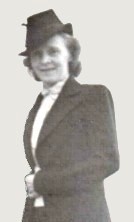 |
|
Birth
name: Clara Balken.
Born 1897(1898) - Died 1964.
Married to Carl from 1938 to 1951.From 1931 Carl settled in
Minneapolis, Minnesota, where he worked at a
girlie magazine named The Calgary EyeOpener: I
met her when I was living in Minneapolis. She was
a telephone operator in the apartment hotel where
I lived. I was still married to my first wife.
In 1935 Carl landed a job at Disney's
in Los Angeles, California: My girlfriend,
who came with me from Minneapolis, quickly got a
job in a printing plant. She was a very beautiful
woman, who in Hollywood circles could have been a
stand-in for Marlene Dietrich! (Later on,
Clara unfortunately developed nerve damage to
her nose, which distorted her features somewhat -
Editor's remark).
In 1942 the couple moved to San
Jacinto, and Clara worked with Carl when he began
his comic book career: I taught her to black
in my stuff, that is, put in the solid blacks
with the brush, and she did that for me for
several years (she also inked the borders
around the panels - Editor's remark). But as
she became more and more of an alcoholic, she got
to where she would get on belligerent spells and
try to tear up a bunch of my drawings. In fact,
that first Uncle Scrooge (FC0386
Only a Poor Old Man - Editor's remark)
I drew that in a motel down in Los Angeles, where
I had taken refuge. She would have torn up my
drawings - and probably chopped me up with a meat
cleaver or something - on one of her big drunks.
But Clara's drinking problems
progressed: She had a lot of talent for
cooking, sewing ... and drinking. She came from a
family that had a long record of alcoholism. And
she just loved the taste of liquor. And so she
kept drinking more and more, and finally she just
got to the point that she was hostile and half
crazy. And she would tear up my comic books and
my drawings if I didn't get them out of sight. I
had to just be walking on eggshells around her,
because you never knew what time she would start
being hostile and want to tear something up. She
did tear up one or two pages that were just in
the beginning stages, the pencil sketches. But
she did take one of my whole 10-page stories
after I'd practically finished it and threw it
outside. Thank God, it was not muddy or wet out
there; they all landed in the dirt.
1951 was a very turbulent year for
the couple: My wife developed a little mole
on the bottom of her foot (it was actually
situated on her shin - Editor's remark), and
she insisted that that was a cancer! She hunted
up a doctor who was easy to convince, so he
arranged for me to take her down to that big
Scripps Institute in La Jolla, and there they
took her into the operating room to remove this
mole, and when she came out of there, she had the
leg off (to the knee - Editor's remark),
and all the leg glands taken out up in the groin.
The doctor said as soon as they took the tissue
out, well, they took a test on it and found out
that it was cancerous tissue, and so they just
went up the leg looking for where it would stop
and cut it off.
The couple had no medical insurance: I was
making enough money with all my cartoon work and
doing those stories to pay all those doctor bills
as I went along (FC0318 No Such
Varmint was one of them - Editor's
remark). Doctor bills weren't so high in
those days; the bill for all that operating was
only 800 dollars.
After the amputation and the recovery Carl
constructed an artificial leg for his wife.
The year ended with a painful
divorce: She divorced me in 1951, took
everything I had except two blankets, my clothes,
my drawing board, and my Geographics (Barks'
copies of the National Geographics magazine -
Editor's remark). And I paid her 250 dollars
a month alimony for 13 years! Always paid her
every month, and she used it to buy more booze.
Eventually she just died of cirrhosis of the
liver. It was alcohol that killed her and it took
13 years to do it.
|

